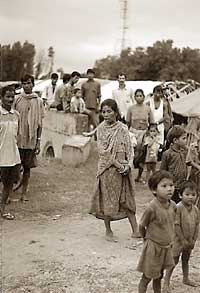 Nepalganj - I am here on a mission-to look at the situation of the freed bonded labourers, Kamaiyas. I wonder, why do we still call them Kamaiya? The system has been banned, why do we not reinstate their identity, their right to recognition as an indigenous people of the tarai who, through circumstances, were reduced to becoming bonded labour.
Nepalganj - I am here on a mission-to look at the situation of the freed bonded labourers, Kamaiyas. I wonder, why do we still call them Kamaiya? The system has been banned, why do we not reinstate their identity, their right to recognition as an indigenous people of the tarai who, through circumstances, were reduced to becoming bonded labour. They are the Tharu, and their despair, a canker sore on development efforts in Nepal. We call them free, but you have to be there to see the futility of the situation. They are free-cardholders categorised like animals for slaughter, red, blue yellow cards, identified by lists issued by the land reform office, receptacles of the government and other development efforts. Man is born free but is everywhere in chains, but they were not even born free.
"I am the seventh generation of kamalahari," says Bhagini. "We still have not been able to leave the zamindar." (Bhagini\'s name has been changed to disguise her identity.) How can they, when half the bataiya grain that they get for sharecropping is further reduced when their "owner", malik, subtracts the rent for the tubewell, the cost of the fertilisers, the pesticides and the beghari, the extra free labour that he elicits from these, his freed kamaiyas.

While floods wreak havoc in the east, here in the west until a week ago, there are no signs of the monsoon, the fields are parched, and the rice seedlings-twice planted-scorched. And again the women of Kanchanpur, fast, praying to their ancestral deities for respite, placating the forest gods.
The Rapti is usually in flood, but now she is a waist-deep stream one can wade across. We say these are Maoist-controlled areas, why would they not be? When one sees the apathy, the frustration of the people who talk of having been given land by the hal ko chaap bhako party, yet have no sale deeds, no claim to ownership. Their women have been asked to work for free, and many have removed their children from schools, as it is more profitable to work as domestic servants. One woman recounts, "I had to work the whole day in the zamindar's house. I had a seven-day-old baby, I could not get time to feed him and I fell sick. Finally my husband refused to work for the landlord and I was given leave."
Her husband now works as mason, a bricklayer, a carpenter and she says proudly, "My children are free. We are the Mukt kamaiyas, we were free even before the government decision." This categorisation has created a division among the community, as there is resentment from those who do not have those promised five kathas of land and Rs 8,000. Those who sit by the edge of the river in makeshift shacks, the donor-given plastic sheets no match for the wind and rain, their dry eyes turning towards the sky waiting in vain for that one drop of rain.
Now on my return, they stand by their flooded fields and shake their heads. One more deluge like the one today, and their efforts are going to be wasted. Each seedling , back-breakingly planted, is going to go under. No more food, no more work and labour lost going to the Indian hired from across the border. Once more will they be the recipients of the landlord's scorn, beaten and driven away from their thresholds. Their sunburnt skin drenched and stretched, their children standing naked, bitten by snakes, purging what little that they have in their stomachs, their women trying to suckle the youngest born on breasts gone long dry, while the gods shed tears in vain.
The scenario unfolds while development churns its gargantuan wheels in the name of poverty alleviation, conflict resolution, rehabilitation and reaching the "poorest of poor", the "marginalised" and the "disadvantaged". How pithy these words are, as the world empathises with taxpayers' money, providing relief, yet asking for community participation. They say it develops a sense of ownership, otherwise the beneficiary becomes "aid dependant". What can these pathetic creatures contribute, when food sufficiency hardly extends more than three months? How can they rise up?



